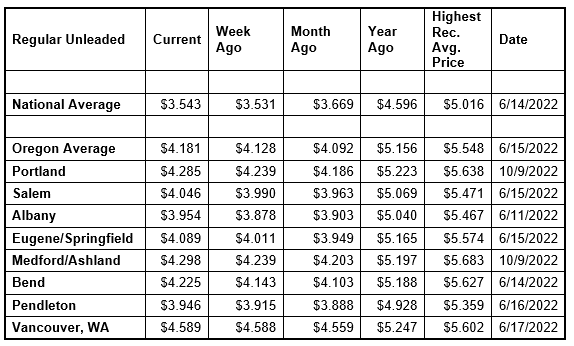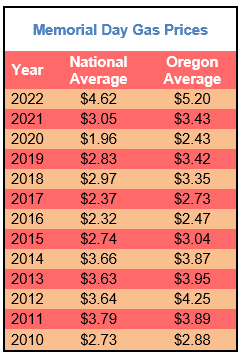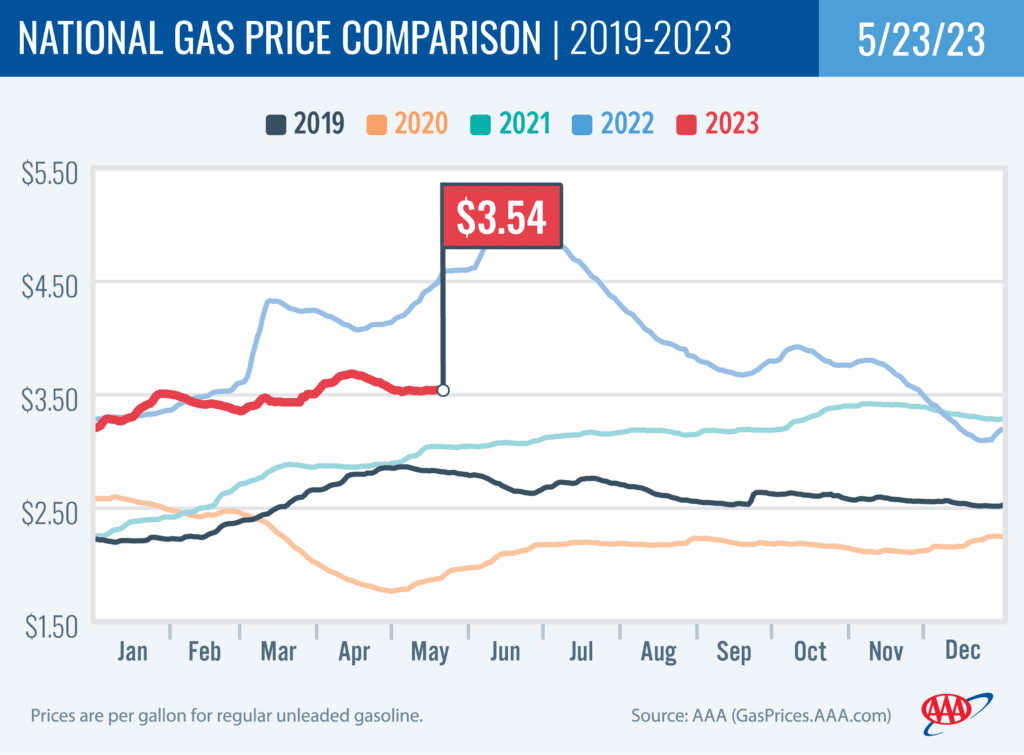PORTLAND, Ore., – Most states are seeing pump prices change by a dime or less on the week as the Memorial Day holiday approaches. Drivers taking a holiday road trip will find gas prices about a dollar a gallon cheaper than last year. For the week, the national average for regular adds a penny to $3.54 a gallon. The Oregon average gains a nickel to $4.18.

“Pump prices have been ticking up ahead of Memorial Day, which is the unofficial start to the summer travel season. Relatively low crude oil costs have helped keep gas prices in check,” says Marie Dodds, public affairs director for AAA Oregon/Idaho.
AAA expects Memorial Day travel volume to be the third busiest on record. AAA projects 42.3 million Americans (12.6% of the population) including 578,000 Oregonians will travel 50 miles or more from home this Memorial Day weekend. This is an increase of 7% over 2022. In all, 2.7 million more people will travel for the unofficial start of summer compared to last year, a sign of a busy summer travel season ahead. Find all the details, top destinations, and tips for travelers in the AAA Memorial Day travel news release.

Crude oil prices have remained below $74 per barrel since May 2 on economic uncertainty and concerns the U.S. may default on its debts. Crude prices fell below $80 per barrel on April 19. Oil prices rose above $80 per barrel after the April 2 announcement from the Organization of the Petroleum Exporting Countries and other major oil producers, including Russia, known collectively as OPEC+, that the cartel would cut oil production by just over 1 million b/d through the end of 2023.
Crude oil is trading around $73 today compared to $71 a week ago and $110 a year ago. In April, West Texas Intermediate ranged between about $73 and $83. In March, WTI ranged between about $64 and $81 per barrel. In February, WTI ranged between about $73 and $80 per barrel. In January, WTI ranged between about $73 and $82 bbl. Crude reached recent highs of $123.70 on March 8, 2022, shortly after the Russian invasion of Ukraine, and $122.11 per barrel on June 8, 2022. The all-time high for WTI crude oil is $147.27 in July 2008.
Crude oil is the main ingredient in gasoline and diesel, so pump prices are impacted by crude prices on the global markets. On average, about 56% of what we pay for in a gallon of gasoline is for the price of crude oil, 20% is refining, 11% distribution and marketing, and 14% are taxes, according to the U.S. Energy Information Administration.
A factor that always puts upward pressure on pump prices in the spring is the seasonal switch to summer-blend fuel. California has an April 1 deadline to switch to summer-blend fuel, while the federally mandated deadline is May 1. The West Coast region often sees prices climb earlier than other parts of the country because of that earlier California deadline. This fuel is more environmentally friendly but more expensive to produce. More info on summer- and winter-blend gasoline can be found at the EPA website.
U.S. refineries often go off-line or have reduced output ahead of these seasonal switchovers so that maintenance can occur. Refineries continue to return to service from extensive winter/spring maintenance, with some planned work extending into June.
Demand for gasoline in the U.S. demand declined from 9.30 to 8.91 million b/d for the week ending May 12. The drop has reduced pressure on pump prices. This compares to 9.03 million b/d a year ago. Meanwhile, total domestic gasoline stocks decreased by 1.4 million bbl to 218.3 million bbl. If gas demand continues to decrease, drivers could see pump prices follow suit.
Quick stats
Oregon is one of 36 states and the District of Columbia with higher prices now than a week ago, and 48 states and D.C. saw prices change by a dime or less in the last week. Michigan (+14 cents) and Wisconsin (+12 cents) are the only wo states with increases larger than 10 cents. Ohio (-10 cents) has the largest weekly decline. The average in Rhode Island is flat.
California ($4.81) has the most expensive gas in the nation for the 12th week in a row. Hawaii ($4.76) is second, Washington ($4.61) is third, Arizona ($4.61) is fourth, Nevada ($4.24) is fifth, Oregon ($4.18) is sixth, and Utah ($4.09) is seventh. These are the seven states with averages at or above $4 a gallon. This week 42 states and the District of Columbia have averages in the $3-range. One state, Mississippi ($2.98) has an average in the $2 range this week, same as a week ago.
The cheapest gas in the nation is in Mississippi ($2.98) and Texas ($3.08). For the 123rd week in a row, no state has an average below $2 a gallon.
The difference between the most expensive and least expensive states is $1.83 this week, compared to $1.82 a week ago.
Oregon is one of only five states with higher prices now than a month ago. The national average is 13 cents less and the Oregon average is nine cents more than a month ago. Utah (+40 cents) has the largest monthly jump. Florida (-32 cents) has the largest month-over-month drop.
All 50 states and the District of Columbia have lower prices now than a year ago. The national average is $1.05 less and the Oregon average is 98 cents less than a year ago. New Jersey (-$1.34) has the largest yearly drop. Arizona (-28 cents) has the smallest. A year ago, pump prices were rising rapidly after the start of the Russian invasion of Ukraine.
West Coast
The West Coast region continues to have the most expensive pump prices in the nation with all seven states in the top 10. It’s typical for the West Coast to have six or seven states in the top 10 as this region tends to consistently have fairly tight supplies, consuming about as much gasoline as is produced. In addition, this region is located relatively far from parts of the country where oil drilling, production and refining occurs, so transportation costs are higher. And environmental programs in this region add to the cost of production, storage and distribution.
| Rank | Region | Price on 5/23/23 |
| 1 | California | $4.81 |
| 2 | Hawaii | $4.76 |
| 3 | Washington | $4.61 |
| 4 | Arizona | $4.61 |
| 5 | Nevada | $4.24 |
| 6 | Oregon | $4.18 |
| 7 | Utah | $4.09 |
| 8 | Alaska | $3.93 |
| 9 | Illinois | $3.92 |
| 10 | Idaho | $3.77 |
As mentioned above, California has the most expensive gas in the nation for the 12th week in a row. Hawaii Washington, Arizona, Nevada, and Oregon round out the top six. Alaska is eighth. Oregon is sixth for the fifth week in a row.
States in the West Coast region are seeing small changes on the week: Arizona (-5 cents),
Oregon (+5 cents), Nevada (+3 cents), Washington (+2 cents), California (+1 cent), Alaska (-2 cents), and Hawaii (-2 cents).
The refinery utilization rate on the West Coast rose from 82.0% to 85.8% for the week ending May 12. This rate has ranged between about 73% to 92% in the last year. The latest national refinery utilization rate is 92.0%.
According to EIA’s latest weekly report, total gas stocks in the region decreased from 29.58 million bbl. to 28.93 million bbl.
A higher refinery utilization rate can put downward pressure on pump prices, while a decrease in gasoline stocks can put upward pressure on pump prices.
Oil market dynamics
Crude oil prices have remained in the low $70s amid ongoing market uncertainty on fears that an agreement won’t be reached on raising the U.S. debt ceiling. The market worries that a default could send the U.S. and global economies into a recession. An economic slowdown would likely lead to lower demand for crude oil and cheaper prices. Additionally, the EIA reported that total domestic commercial crude inventories increased by 5 million bbl to 467.6 million bbl last week.
At the close of Friday’s formal trading session, WTI lost 31 cents to settle at $71.55. At the close of Monday’s formal trading session, WTI added 44 cents to close at $71.99. Today crude is trading around $73, compared to $71 a week ago. Crude prices are about $41 less than a year ago.
Drivers can find current gas prices along their route with the free AAA Mobile app for iPhone, iPad and Android. The app can also be used to map a route, find discounts, book a hotel and access AAA roadside assistance. Learn more at AAA.com/mobile.

Diesel
For the week, the national average loses three cents to $3.99 a gallon. The record high is $5.816 set on June 19, 2022. The Oregon average slips two cents to $4.46. The record high is $6.47 set on July 3, 2022. A year ago the national average for diesel was $5.55 and the Oregon average was $5.67.
Find current fuel prices at GasPrices.AAA.com.
AAA news releases, high resolution images, broadcast-quality video, fact sheets and podcasts are available on the AAA NewsRoom at NewsRoom.AAA.com.
Find local news releases at https://oregon.aaa.com/community/media/media-contacts.html
Fuel prices are updated daily at AAA’s Daily Fuel Gauge at AAA Gas Prices. For more info go www.AAA.com. AAA Oregon/Idaho provides more than 880,000 members with travel, insurance, financial and automotive-related services, and is an affiliate of AAA National, serving more than 63 million motorists in North America.

